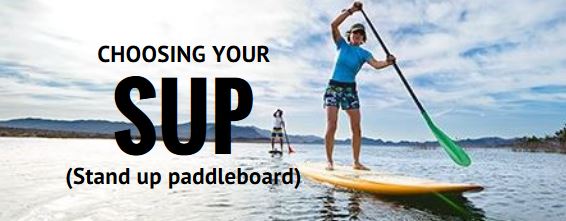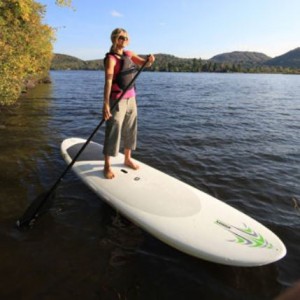
Once you’ve been bitten by the stand up paddle boarding (SUP) bug, you’ll soon want to buy your own SUP. To find the right one, think about the type of paddle boarding you’ll be doing:
Fun and fitness: This includes leisurely outings and fitness sessions on flat water and catching small- to medium-size waves in the ocean. Most beginners will fall into this category. Your primary considerations when choosing a SUP for all-around use and surfing are stability and maneuverability.
Touring or racing: This type of paddling involves covering long distances and reaching high speeds. Your primary considerations when  choosing a SUP for racing/touring are speed and efficiency in the water. Hull type, volume, length, width, core materials and fins all affect a board’s stability, maneuverability, speed and efficiency. These features are detailed below to help you choose the right SUP.
choosing a SUP for racing/touring are speed and efficiency in the water. Hull type, volume, length, width, core materials and fins all affect a board’s stability, maneuverability, speed and efficiency. These features are detailed below to help you choose the right SUP.
SUP Hull Types: The hull, or body, of a paddle board plays a major role in determining how the paddle board performs in the water. SUPs have one of two hull types: planing or displacement.
Planing Hull: Best for anyone who wants one board to do it all. A planing hull is flat and wide, similar to a surfboard. It is designed to ride on top of the water and performs great in ocean waves as well as your favorite lake. Many beginner paddle boarders start on boards with planing hulls because they tend to be stable and are versatile for recreational paddling and surfing.
Displacement Hull: Best for paddling long distances and racing. These have a pointed nose or bow (front end) similar to that of a kayak or canoe. A displacement hull slices through water, pushing the water around the nose to the sides of the SUP to improve efficiency. In order to push the least amount of water possible, SUPs with displacement hulls are usually longer and narrower than SUPs with planing hulls. This makes them faster, but they can also be tippier.
Learn the next 4 criteria at the original article on REI Expert Advise here!
Posted by Scott Freerksen “The Lake Guy”
